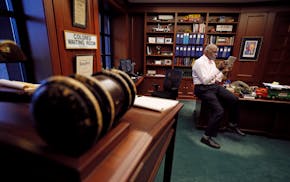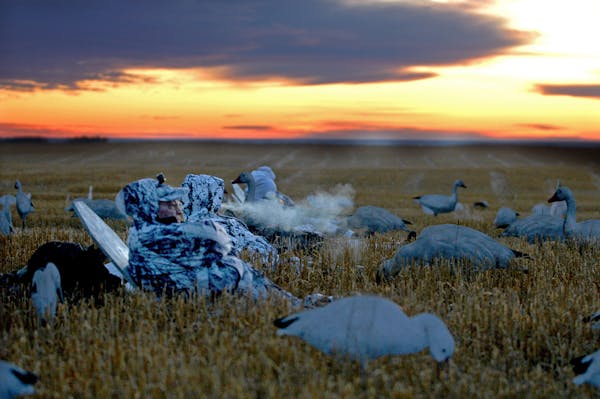Alaska's "Last Great Race" begins this weekend — the Iditarod Trail sled dog adventure over 1,000 miles that conjures up images of unbreakable mushers, resilient huskies and wildly beautiful but unforgiving landscapes.
A Minnesotan on the trail but not competing stands to experience his own great race — again.
Enduring whatever may come in the crosswinds of the Alaska wilderness and the unexpected, Ian Planchon will be afield as one of the race's cinematographers. In Planchon's case, he and a guide shadow the race leaders over the nine or so days of the Iditarod. He and his partner, Sacha Gros, are veterans of the event in their own right. This year marks Planchon's 16th Great Race.
Like Planchon and Gros, a second camera team documents the action at the middle of the pack. Then there are four camera people to cover the race checkpoints, leap-frogging point to point and transported by plane — the best means to navigate such rough terrain. Planchon drives a high-end snowmachine (aka a snowmobile in the Lower 48), as does Gros, who will tow a trailer packed with food and gear. Parts are moving.
Planchon, 40, and Gros will track the mushers in first through fifth place before a clear top three emerge. Last year, Brent Sass and Dallas Seavey, a five-time Iditarod champion, were those mushers. Sass, a former Minnesotan from Excelsior, went on to win his first.
"It's a logistical nightmare to cover this race," Planchon said. "You have to be able to move people around. Weather is a big factor. Fuel for everybody. You got to have food for everybody. It's just a big traveling circus."
Planchon isn't just packing Snickers bars, Wintergreen fleece and face protection. He brings a sense for storytelling and an eye and talent for documenting arresting visuals. He and his wife, Lynn Melling, founded and run 515 Productions, a video production company. Close to home, they've channeled their passion for the outdoors and their skills into an award-winning documentary, "Freshwater," about Lake Superior's winter surfing community.
Yet Alaska is home, too, for Planchon and Melling. Planchon grew up in Anchorage, and the two met at a TV station there in 2001 before moving to Des Moines, in 2006. They've been in Minnesota (which is home for Melling) since 2016.
Planchon, of Golden Valley, recalled the Last Frontier was the ideal setting to cultivate a connection to the natural world. He documented and filmed action sports and adventures for years in Alaska, where he landed an internship at an NBC affiliate TV station and would become a staff photographer. Years later, while he freelanced in Des Moines, his old TV station boss came calling to see if he'd cover the Iditarod. He did that for two years before learning of an internal race group, the Iditarod Insiders, the race's video production company. It needed a camera operator. Planchon was all-in.
During an interview this week before he left for Anchorage, Planchon talked, among other things, about his behind-the-scenes vantage point at the Iditarod, the rules of engagement on the course and his most-gripping experiences. The excerpts have been edited for clarity and length.
On a typical day
"From the very beginning, following the first through fifth place, the race is constantly changing. Generally, we won't sleep for the first 36 hours. They are the hardest by far but they set the tone. Right off the bat, you are sleep-deprived. We'll get to checkpoints Nikolai, McGrath or Ophir. If everything goes well, we can sleep for four or five hours. Then by that time, first place is coming to the checkpoint and we will leave to get ahead of them. We pass them two to three times and then we don't bug them for hours and hours … We'll document [others] and catch back up to first place."
On being sensitive to the mushers and dogs
"We have some hard-and-fast rules that we have created to make sure everyone gets the same treatment from camera teams. Number one, if we are driving down the trail and that musher is sleeping, we try to give them as wide a berth as possible because it sucks when you are down sleeping and two snow machines rip by. We don't stop. We don't interview them. We let them rest because that is what they need. If they are awake, we do need to tell the story. We will stop and shoot footage from afar. Then, we'll walk up. They all know me now which is great and makes it a lot easier. There are some racers who love working with the camera teams. They know in order to make the Iditarod get the attention it deserves and get the fan base up, they need to be able to interact with the camera teams. There are some that understand it, but they understand that this is a race and they want to win, and they are a little more stingy. They don't like it when we get too close to the dogs. They don't like it when we wake the dogs up. But we understand that. We don't want to interfere. It is a fine line."
On the evolution of the racers
"[The Iditarod] has 51 years to evolve. You used to be able to have more than 16 dogs. The number that you could finish with was low, too. The one thing that has evolved is how much the Iditarod pays attention to dog health. The veterinarians are high caliber and pay close attention to dog health. The second is holding racers accountable for dog health.
"Racers have tweaked their sleds or tweaked their methods to get an edge. When I first started you couldn't have any devices that connected to the internet. You couldn't have any devices that were communication devices. You had a satellite spot device to signal for trouble and a tracking device, but that was it. You couldn't make phone calls. You couldn't figure out a strategy about who was where. That has all changed. You can make phone calls from the trail now. I am not the biggest fan of that, but technology has made it to the point where you can't fight that.
"When people introduced seats behind their sleds and could sit down … everyone was like, 'Whoa, that changes the game a bit.' You are not just running the entire time or standing the entire time. Now you can get some rest. That was met with a little bit of controversy, as well, because it was like, now you are just making the dogs do all the work. But you look at the top of the top — Jeff King, Dallas and Mitch Seavey, Brent Sass, Lance Mackey — those guys worked hard. So when they are sitting down, you couldn't fault them. I think it was OK that they took a seat now and then."
On Sass, the former Minnesotan
"He has just so much fun [racing]. That is what makes this race so cool. You are going to have some people that are very serious and very focused and want to win. You have others who really just enjoy this sport and want to share that passion with everybody. Those are the stories we love telling because it is hard not to love those stories, right? I love the intensity and I love the passion, and I think you need both. One doesn't drive without the other."
On the community of the race
"When you get into a checkpoint, that is where it gets amazing. The villagers put together potlucks and bring them to community halls. Everyone is cooking something that they have been cooking forever, whether it is moose stew, moose burgers, moose sausage, bear stew. You get a local flavor at each of these checkpoints. It is so amazing to see how these villagers come out to support the race, and the Iditarod supports these villages. You can't find places like this in the Lower 48. They don't exist. These villages are so far removed from everywhere. It's so amazing to be a part of it and to see how these lifestyles still exist out there."
On possible emergencies
"If anyone helps a musher in any way, that racer is disqualified. That being said, there have been times when mushers have had emergencies and our snow machine teams have had to be the people who rescued. Because we are out on the trail as much as we were, we are looked at as the first responders if we are close to the action."
On hairy, exciting moments
"Last year's blizzard was the worst one I've been caught in. But it is this weird thing with this race. You are in it and have been in it for so long. The blizzard happened at the end of the race. We're nine days in; we've seen everything. It gets to this point where, yeah, this is intense weather, but this is the race. I guess that is why we are some of the few who can document this race because we have this drive to get the camera out. Last year it went bright, blue sunny skies as we were leaving the last checkpoint to full blizzard, 75 mph, 30- or 40-below windchill. It was a bad, bad storm, but that's the Iditarod and we're there to capture these moments."

Twins pitcher Ober struggling to regain fastball velocity

Twins lose second in a row to Blue Jays as bullpen falters late

The PWHL's growth comes with a price for a Minnesota Frost team building a potential dynasty
What is the 'House settlement,' and what does it mean for the Gophers and NCAA?




